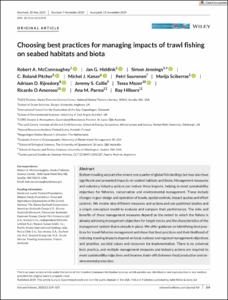| dc.contributor.author | McConnaughey, Robert A. | |
| dc.contributor.author | Hiddink, Jan G. | |
| dc.contributor.author | Jennings, Simon J. | |
| dc.contributor.author | Pitcher, C. Roland | |
| dc.contributor.author | Kaiser, Michel J. | |
| dc.contributor.author | Suuronen, Petri | |
| dc.contributor.author | Sciberras, Marija | |
| dc.contributor.author | Rijnsdorp, Adriaan D. | |
| dc.contributor.author | Collie, Jeremy S. | |
| dc.contributor.author | Mazor, Tessa | |
| dc.contributor.author | Amoroso, Ricardo O. | |
| dc.contributor.author | Parma, Ana M. | |
| dc.contributor.author | Hilborn, Ray | |
| dc.date.accessioned | 2021-07-30T20:17:43Z | |
| dc.date.available | 2021-07-30T20:17:43Z | |
| dc.date.issued | 2020 | |
| dc.identifier.citation | McConnaughey, R.A., Hiddink, J.G., Jennings, S., et al. (2020) Choosing best practices for managing
impacts of trawl fishing on seabed habitats and biota. Fish and Fisheries, 21, pp.319–337. DOI: https ://doi.org/10.1111/faf.12431 | en_US |
| dc.identifier.uri | https://repository.oceanbestpractices.org/handle/11329/1636 | |
| dc.identifier.uri | http://dx.doi.org/10.25607/OBP-1568 | |
| dc.description.abstract | Bottom trawling accounts for almost one quarter of global fish landings but may also have
significant and unwanted impacts on seabed habitats and biota. Management measures
and voluntary industry actions can reduce these impacts, helping to meet sustainability
objectives for fisheries, conservation and environmental management. These include
changes in gear design and operation of trawls, spatial controls, impact quotas and effort
controls. We review nine different measures and actions and use published studies and
a simple conceptual model to evaluate and compare their performance. The risks and
benefits of these management measures depend on the extent to which the fishery is
already achieving management objectives for target stocks and the characteristics of the
management system that is already in place. We offer guidance on identifying best practices
for trawl-fisheries management and show that best practices and their likelihood of
reducing trawling impacts depend on local, national and regional management objectives
and priorities, societal values and resources for implementation. There is no universal
best practice, and multiple management measures and industry actions are required to
meet sustainability objectives and improve trade-offs between food production and environmental
protection. | en_US |
| dc.language.iso | en | en_US |
| dc.rights | Attribution 4.0 | * |
| dc.rights.uri | http://creativecommons.org/licenses/by/4.0/ | * |
| dc.subject.other | Trawling effects | en_US |
| dc.subject.other | Bottom trawls | en_US |
| dc.subject.other | Benthos | en_US |
| dc.subject.other | Dredging | en_US |
| dc.subject.other | Ecosystem-based fishery management | en_US |
| dc.subject.other | Impact-yield model | en_US |
| dc.subject.other | Trade-offs | en_US |
| dc.title | Choosing best practices for managing impacts of trawl fishing on seabed habitats and biota. | en_US |
| dc.type | Journal Contribution | en_US |
| dc.format.pagerange | pp.319-337 | en_US |
| dc.identifier.doi | https://doi.org/10.1111/faf.12431 | |
| dc.subject.parameterDiscipline | Fisheries | en_US |
| dc.bibliographicCitation.title | Fish and Fisheries | en_US |
| dc.bibliographicCitation.volume | 21 | en_US |
| dc.description.sdg | 14.4 | en_US |
| dc.description.eov | Fish abundance and distribution | en_US |
| dc.description.methodologyType | Reports with methodological relevance | en_US |
| obps.contact.contactemail | bob.mcconnaughey@noaa.gov | |
| obps.resourceurl.publisher | https://onlinelibrary.wiley.com/doi/10.1111/faf.12431 | |
 Repository of community practices in Ocean Research, Applications and Data/Information Management
Repository of community practices in Ocean Research, Applications and Data/Information Management

